Table of Contents
If you are trying to lose weight, a well-balanced diet will help you more than anything else. Even better is knowing the best foods to eat to lose weight. We bring into focus 25 nutritious foods that can support your weight-loss goals, keep you feeling full, and promote fat-burning. Learn about healthy meals you can prepare and our 7-day plan for healthy weight loss.
1‒5: Whole foods
You may have come across what is called the ‘Mediterranean diet’. It is a well-known diet for healthy weight loss centered around eating whole foods (1).
Whole foods are minimally processed, meaning they retain most nutrients and fiber. Whole foods are wholesome and a much healthier option than processed foods.
Eating whole foods provides better satiety. This way, you can manage hunger pangs and eat less while still getting enough nutrition. A diet rich in whole foods helps to promote weight loss and lowers the risk of disease (2).
Here are the fab five of whole foods for shedding those pounds:
1. Quinoa
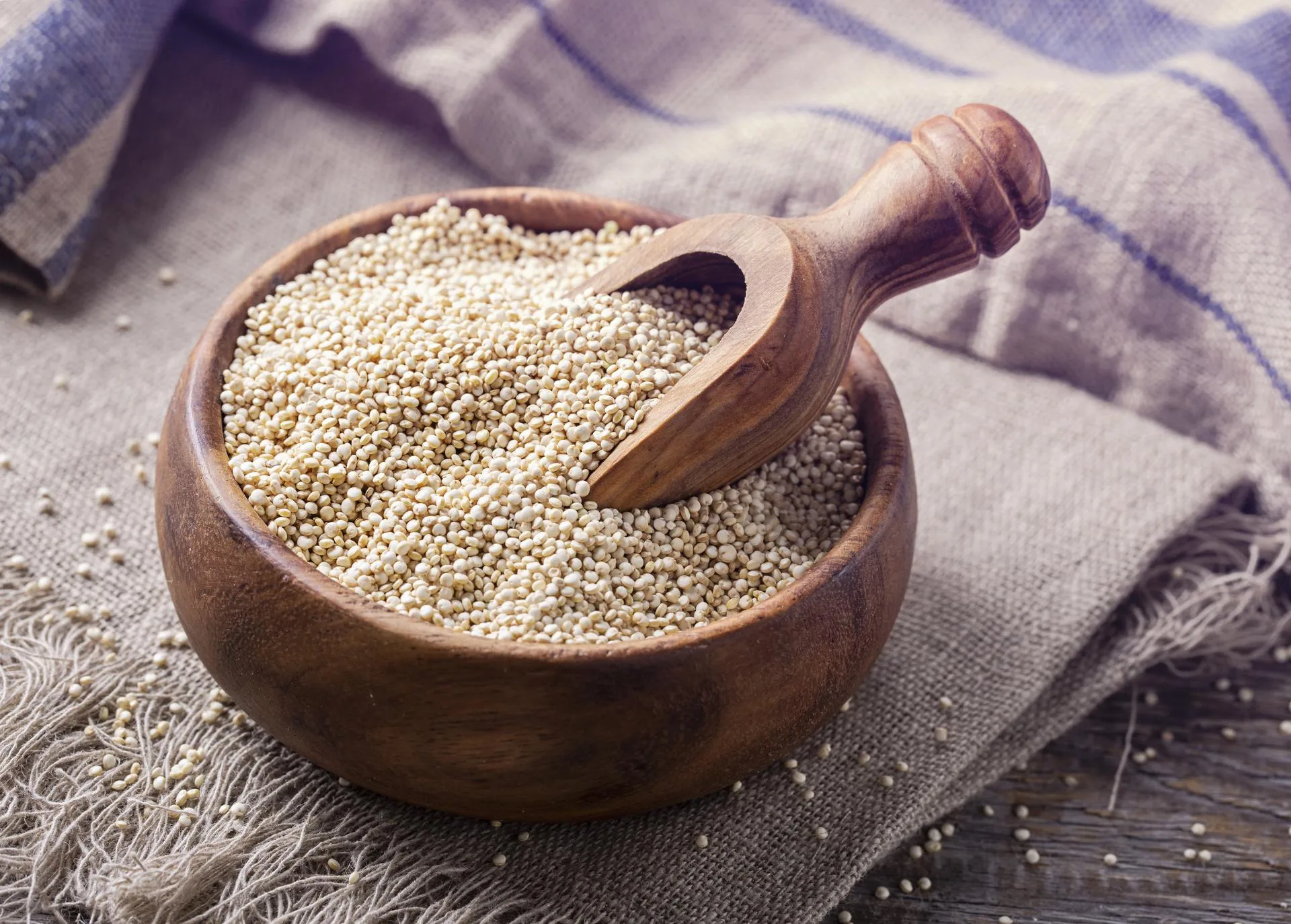
Quinoa consists of seeds teeming with nutrients, and it’s gluten-free. Surprisingly, quinoa is not classified as a grain. Within each tiny seed is a wealth of essential vitamins, minerals, and protein (3, 4).
Quinoa may not directly burn fat, but it can support healthy digestion and help regulate blood sugar levels (5). This natural food is also a fantastic reservoir of vegetarian-friendly proteins.
Quinoa is also delicious and versatile! As a starting point, you can use it as the base for salads, stir-fries, or soups. Also, why not try fashioning patties or ‘falafel’ balls into veggie burgers? The possibilities are endless.
2. Chia seeds
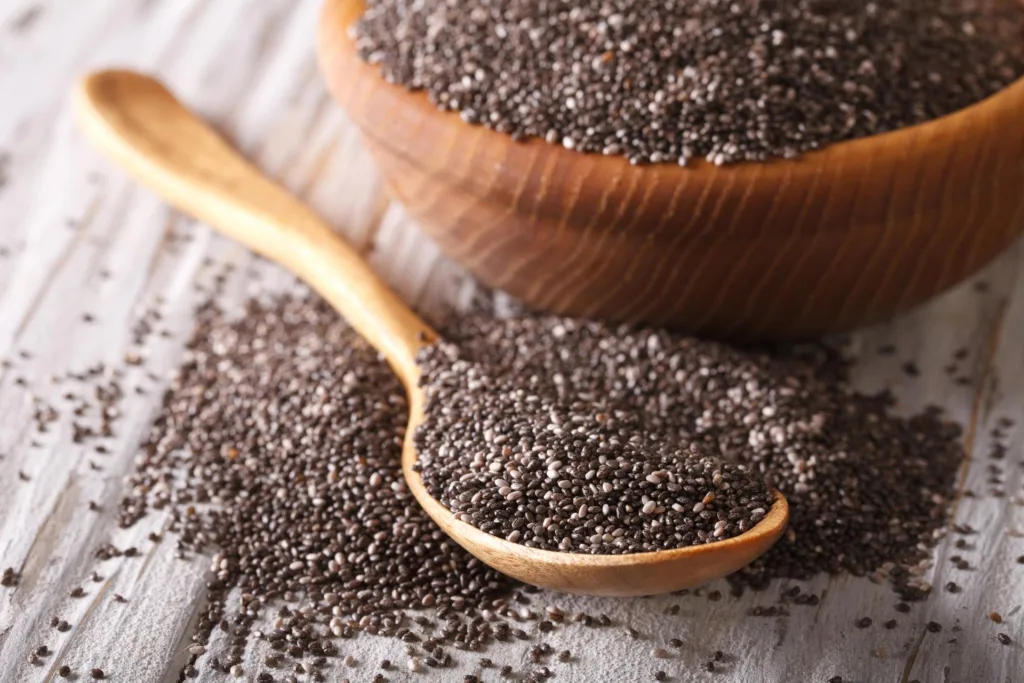
These little black and white seeds have nourishing fiber, protein, and healthy fats to keep you feeling full for longer. This can help you eat fewer calories and, ultimately, help you reach your weight-loss goals (6, 7). However, more research is needed to assess if there is a true impact on weight loss (8).
Also, the antioxidants found in this tiny superfood hold the potential to reduce inflammation and improve your overall health (9).
In what way can you enjoy chia seeds every day? They add a delicious nutty flavor to any dish or snack. Try blending them into your wholesome smoothie or spreading them over oatmeal or yogurt.
If you want to get creative, mix them into flour for mouth-watering baked goods.
3. Whole grains
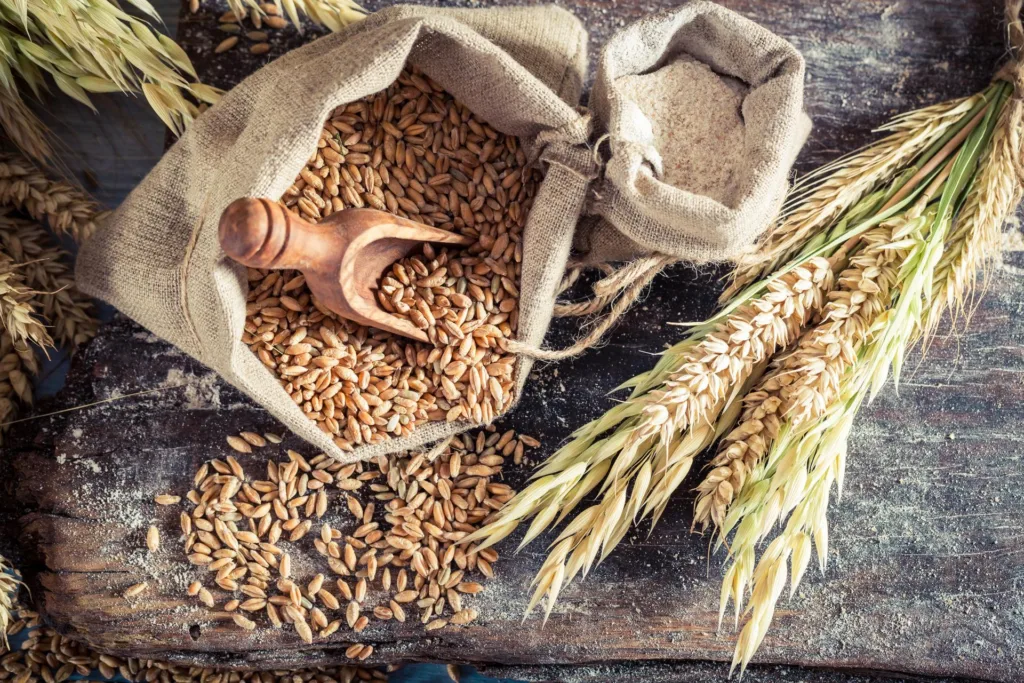
Starting your morning with nutritious whole-grain cereal, oats, or bread can set the tone for the rest of your day.
The main problem with refined grains is that they are stripped of nutrients like fiber. Dietary fiber can increase satiety, helping you combat junk food cravings (10, 11).
In a study, people who consumed no less than three portions of whole grains daily had 10% less belly fat than those who didn’t eat any (10). Another study reveals that whole grains can even help curb long-term weight gain in men (12).
As a staple, the ideas for whole grains in your diet are endless. For the adventurous, try toasting oats for an extra smoky flavor, including bulgur and farro in salads, or even top your ice cream with roasted brown rice!
4. Beans, lentils and legumes
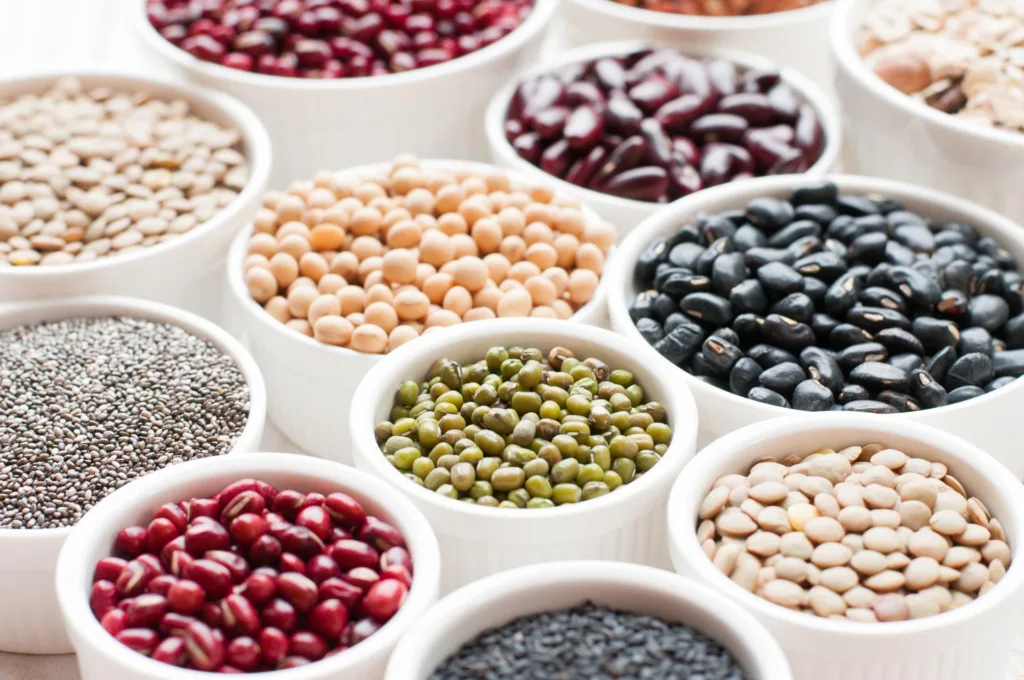
Beans and legumes can be a fabulous addition to any healthy diet. They’re full of protein and fiber that promote satiety (13, 14).
They also contain resistant starch, which can trigger fat burning, lessen fat storage, and potentially mute your hunger signals (15).
A study also showed that women who regularly consume beans and legumes have lower body fat and smaller waists than those who don’t eat these culinary gems (16).
To enjoy beans and legumes, you can easily tuck them into a bed of greens, whip up a hearty soup, or even add them to an omelet.
5. Berries
Berries are low in calories and fat but full of vitamins, minerals, and antioxidants (17). The impressive vitamin B content in berries can stimulate thyroid hormones and boost metabolism (18).
A serving of 100 grams of fresh berries is a great choice for a guilt-free dessert or sweet treat. One serving only provides about 2‒5% of your recommended daily value (DV) of carbs but contains 7‒21% DV of fiber (19).
Berries have some of the highest antioxidant values of all fruits. These little fruits work to safeguard your body against free radical harm and reduce the risk of chronic diseases, including cancer (20).
A nutritious dessert could comprise a variety of berries. Try juicy strawberries or blueberries with tangy raspberries or rich blackberries. Berries are good just as they are or blended into a smoothie, but baking healthy berry treats is another way to go.
6‒10: Lean proteins
Experts agree that proper protein intake is essential. Protein is essential for cellular support and growth and supports a healthy metabolism (21).
Protein also contributes to fat and calorie burning. It also can help to curb cravings, as supported by various studies (22, 23).
One simple tip is to start your day with a high-protein breakfast, which can improve appetite management throughout the day (24, 25).
Set your sights on including these five lean protein sources in your diet to keep you on track toward healthy weight loss.
6. Chicken breast
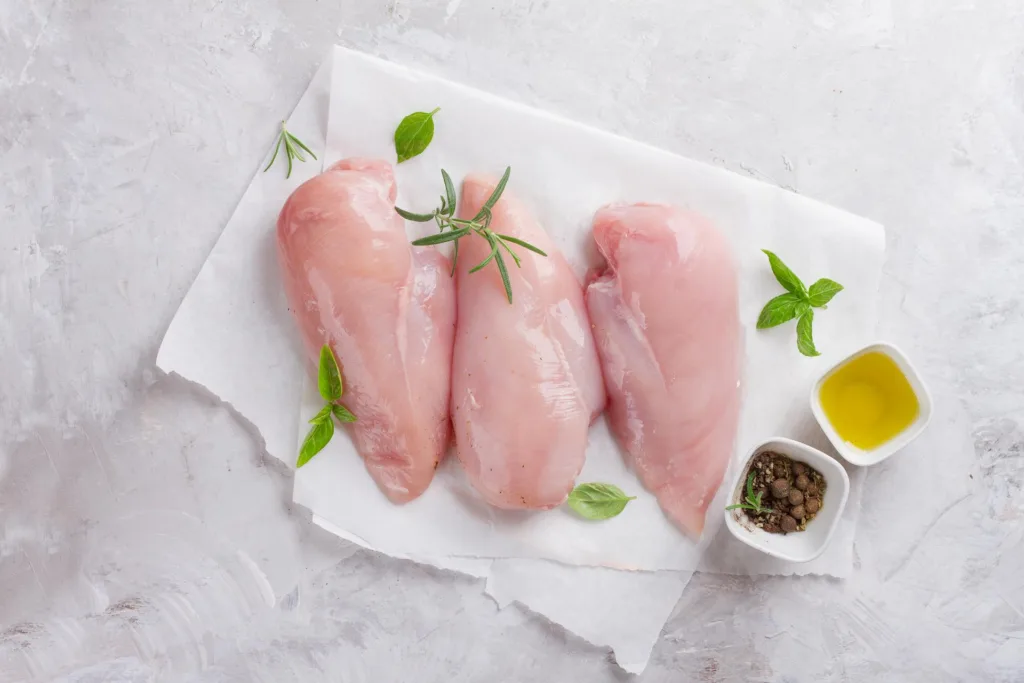
Chicken breast is a delicious go-to for protein (46% DV per 100 grams). It is low in fat and calories, making it an ideal choice for losing weight (26, 27).
Preparing chicken breast is easy and versatile. You can opt for the popular choice of cooking it on a grill top. Roasting alongside vegetables is a more nutritious option.
Skinless chicken breast is the best choice to avoid fat and lower calories. Seasoning with herbs and spices or marinating it can add more nutritional value.
7. Greek yogurt
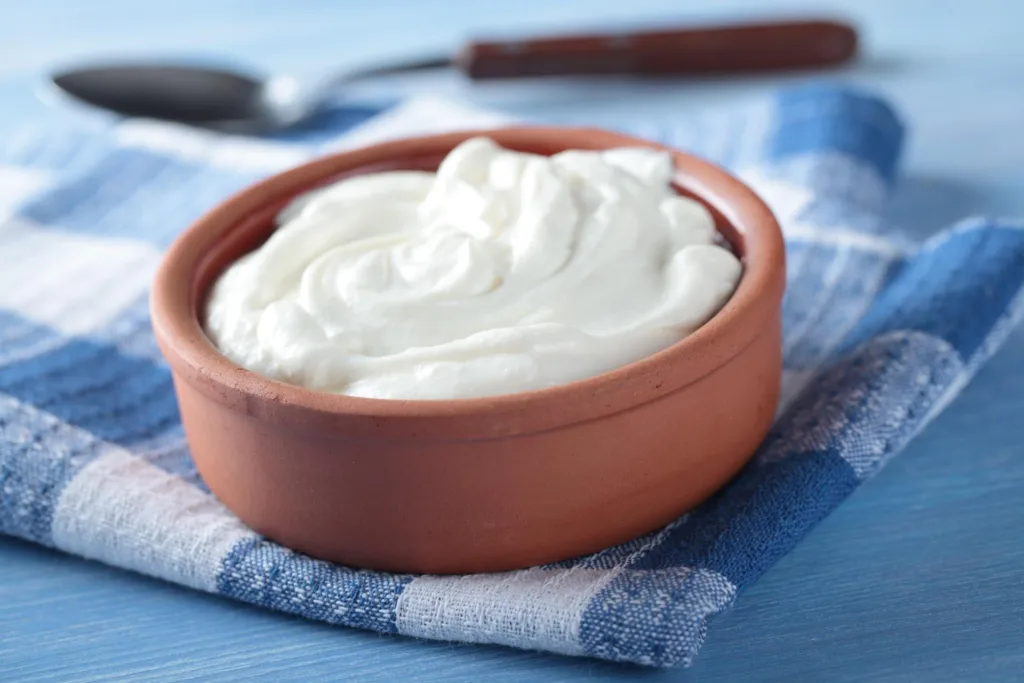
Greek yogurt is a top-notch yogurt. Whey and lactose are drained from the yogurt, making it way thicker and creamier than regular types.
This process boosts protein levels (20% DV in 100 grams) and lowers sugar and carb content (28, 29).
Greek yogurt is also jam-packed with calcium and gut-friendly probiotics for keeping your microbiome healthy, which can accelerate fat loss (30).
With its distinctly tangy and tart taste, Greek yogurt is a favorite in many recipes. You can use it instead of sour cream or mayo while crafting creative recipes. Add a handful of fresh fruit, nuts, or granola for a tasty, nutritious breakfast.
If you’re looking for other dairy products that are protein-packed, give cottage cheese and kefir a try.
8. Tuna
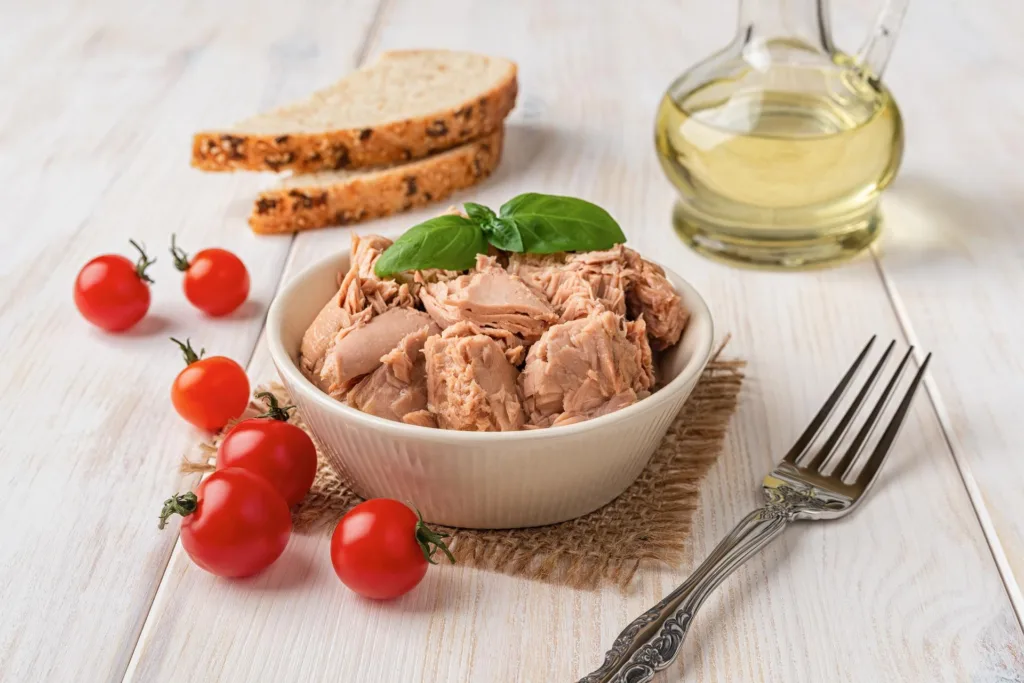
Tuna is a super lean fish high in protein (49% DV per 100 grams!) and healthy fats (31). It’s also rich in omega-3 fatty acids (comprising DHA and EPA), and these beneficial fats nourish your heart and improve brain function (32, 33).
Tuna is also a good source of vitamin D—integral to bone and immune health. Despite some claims, there is not enough clear evidence to show that vitamin D can directly support weight loss (34, 35).
Tuna is, of course, popular in salads, on a sandwich, or you can grill it as a main course. If you choose canned tuna, make sure it’s water-based and also low in sodium.
9. Eggs
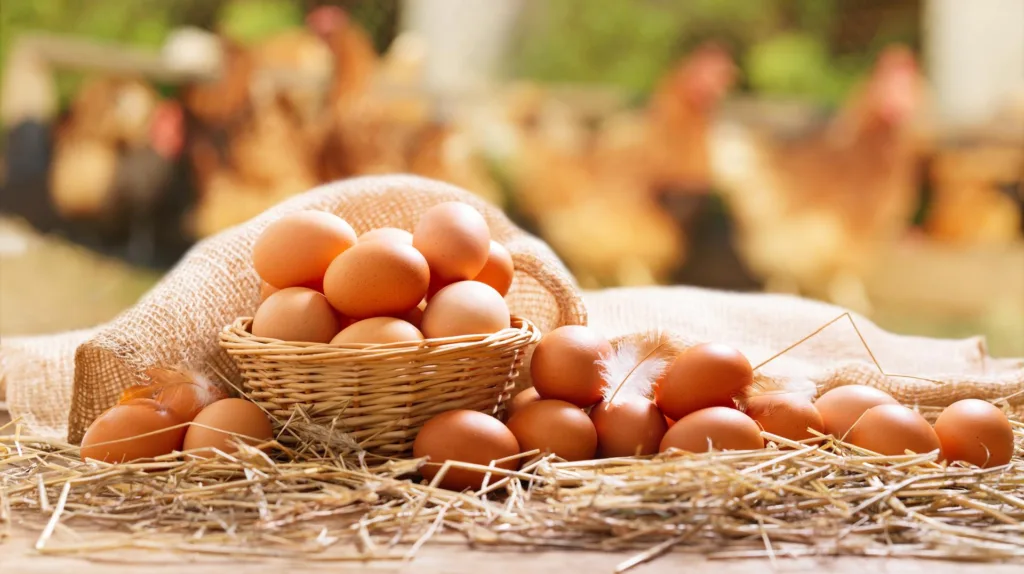
Eggs have plenty of nutrients, most of which can be found in the yolk, including most of the choline and vitamin D (36).
A whole egg has an impressive 5-8 grams (10-16% DV) of protein (36). The copious amount of protein and fat in eggs can help you feel full and satisfied, thus, fostering weight loss (37).
Although some claim that eggs are high in cholesterol, most people can safely consume a modest quantity of 7-12 eggs per week (38).
10. Chickpeas
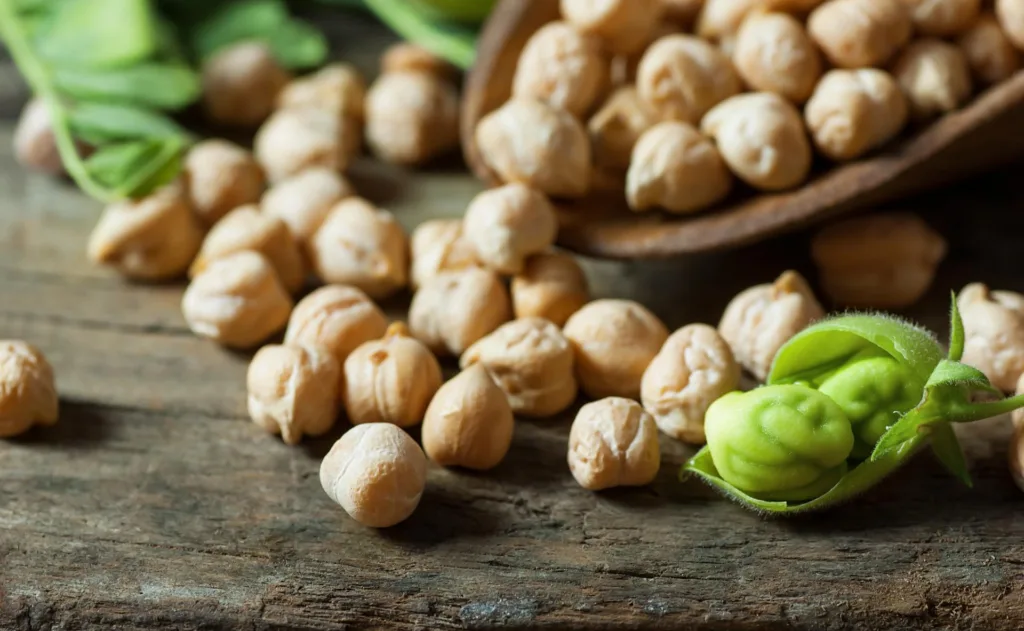
Beans of the garbanzo variety, or chickpeas, are a type of legume with remarkable plant-based protein content.
In fact, 100 grams of cooked chickpeas contains a whopping 9 grams (17% DV) of protein! Its impressive protein and fiber content can help you feel fuller for longer, making it easier to manage food cravings and reduce snacking (39).
Chickpeas also have a low glycemic index, which means they won’t spike your blood sugar levels. This helps regulate insulin levels which benefits weight loss (40).
There are so many delicious ways to get your chickpea fix. You can roast them as a crunchy snack, toss them into stews and salads, or whip up a tasty hummus dip. For a fancy and filling meal, try a chickpea curry or falafel wrap.
11‒15: Healthy fats
Despite popular notions, not all fats are bad for you. Some fats are essential to a healthy eating regimen and can actually help you lose weight (41).
There are three healthy unique forms of dietary fat—saturated, poly-unsaturated, and monounsaturated. Each type is necessary for your diet, and every food that contains fat has a mix of all three types (42, 41).
Fats can amplify the absorption of vitamins A, D, E, and K, which are known as fat-soluble vitamins. These vitamins support your immune and skeletal systems, as well as your heart and skin (43).
Consuming healthy fat can boost feelings of fullness. In addition, they can fight inflammation, and a balanced ratio can support your heart (44, 45).
Don’t shy away from including nourishing fats in your meals. Check out these top five foods loaded with healthy fats for a slimmer you.
11. Avocado
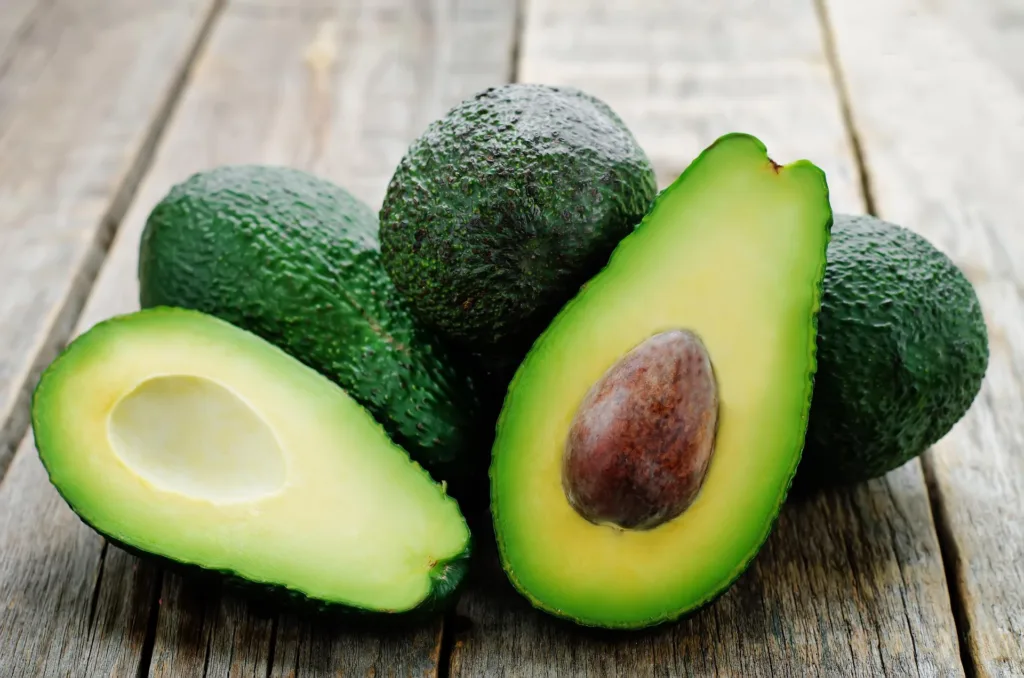
Unlike most fruits high in carbs, avocados are loaded with healthy fat instead.
The humble avocado has prolific monounsaturated oleic acid akin to that found in olive oil. Enough of these fats can boost your metabolism, cut down on inflammation, and make you feel full for longer (45, 46).
And despite being mostly fat, avocados are also super hydrating and full of fiber, making them incredibly satiating (47). They also help your body absorb fat-soluble vitamins like E and K (48).
Apart from ubiquitous avocado toast or salad, avocado can also be a healthy substitute for butter on bread or mayonnaise in some recipes!
12. Salmon
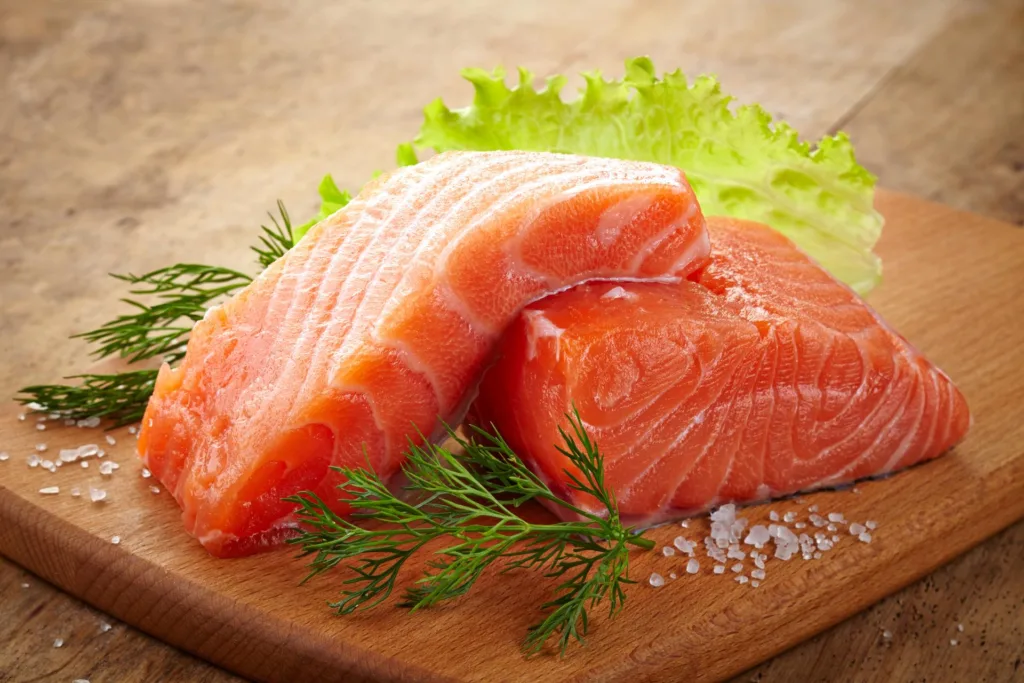
Salmon is a great choice for a healthy weight-loss diet because it packs a nutritional punch. This fatty fish is high in protein and rich in poly-unsaturated omega-3 fatty (n-3 PUFA) acids. This means additional support for a healthy heart and brain (45).
Research shows that eating salmon can help you lose weight by increasing satiety, reducing inflammation, and lessening overall calorie intake, partly due to n-3 PUFA (50, 32, 51).
Salmon is also a source of nourishment with life-sustaining nutrients like vitamin D, vitamin B12, and selenium to fortify our immune system (52).
Grilling salmon can take off excess fat, but baking with seasonings like garlic and dill adds even more goodness.
Other healthful oily fish that can help you lose weight are mackerel, trout, sardines, herring, and tuna.
13. Animal fats
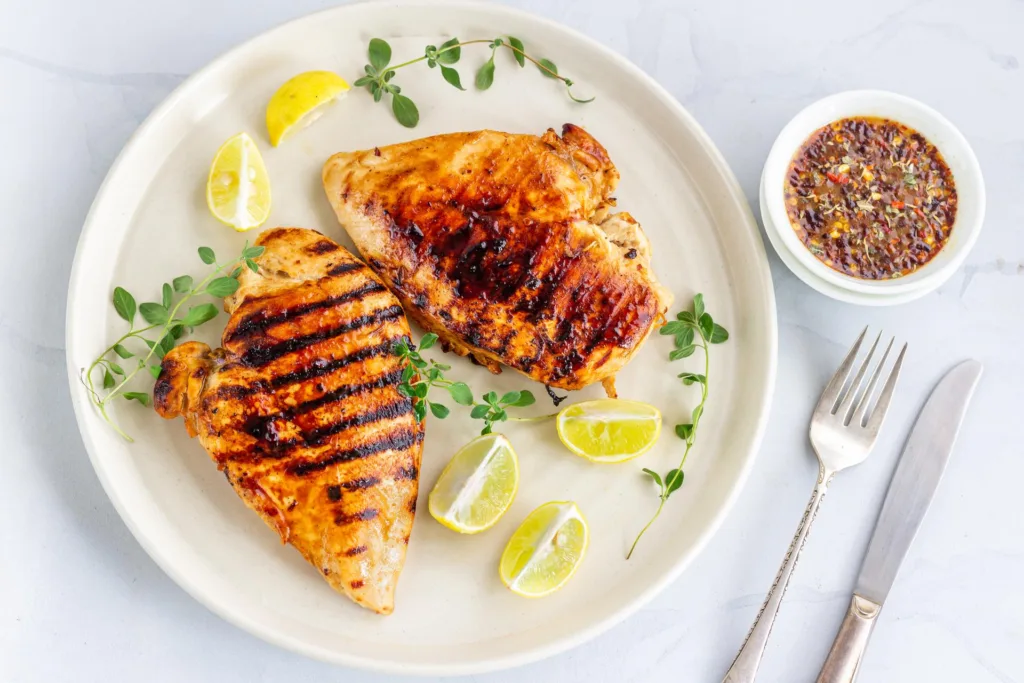
Animal fat used in cooking comes from beef (tallow), pork (lard), or sometimes mutton. Lately, these fats have gotten a bad rap for no good reason, but they are healthy if you don’t go overboard (53, 54).
Animal fat has a higher smoke point (when oil starts to burn) compared to other cooking fats and oils. In other words, it can handle high heat better. It is, therefore, a good choice for frying and roasting (55).
Animal fats and lards are high in saturated fat but also rich in CLA (Conjugated Linoleic Acid). This fatty acid can support a healthy metabolism and may even help burn fat (41, 56).
Moreover, lard comprises over 60% unsaturated fat (mostly monounsaturated), which is one of the most beneficial fats (41).
Using animal fat can add a delicious and satisfying flavor to any dish and motivate you with your weight-loss diet. Just remember to use it in moderation as part of a balanced diet.
14. Almond
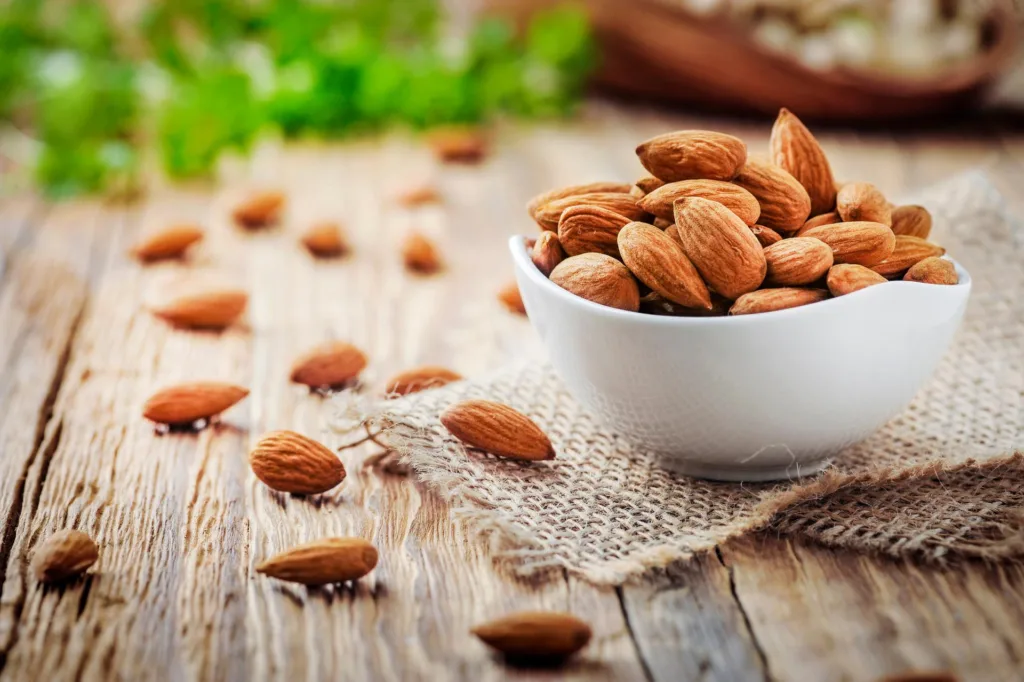
Almonds are basically super nuts full of healthy monounsaturated fats, fiber, protein, and other plant compounds that keep your heart healthy (57, 41).
They are an excellent snack for losing weight. They make you chew, which slows you down eating. This can help you experience a greater sense of satiety (58).
Eating a serving of almonds a day has been linked to reducing belly fat, leg fat, and weight loss in many women (59, 60).
Chopped roasted almonds in yogurt or oatmeal is a no-brainer, but you can also blend them into a smoothie. Combining with other nuts, especially in a trail mix, is doubly beneficial.
Pistachios and walnuts make equally great weight-loss partners (41).
15. Canola oil
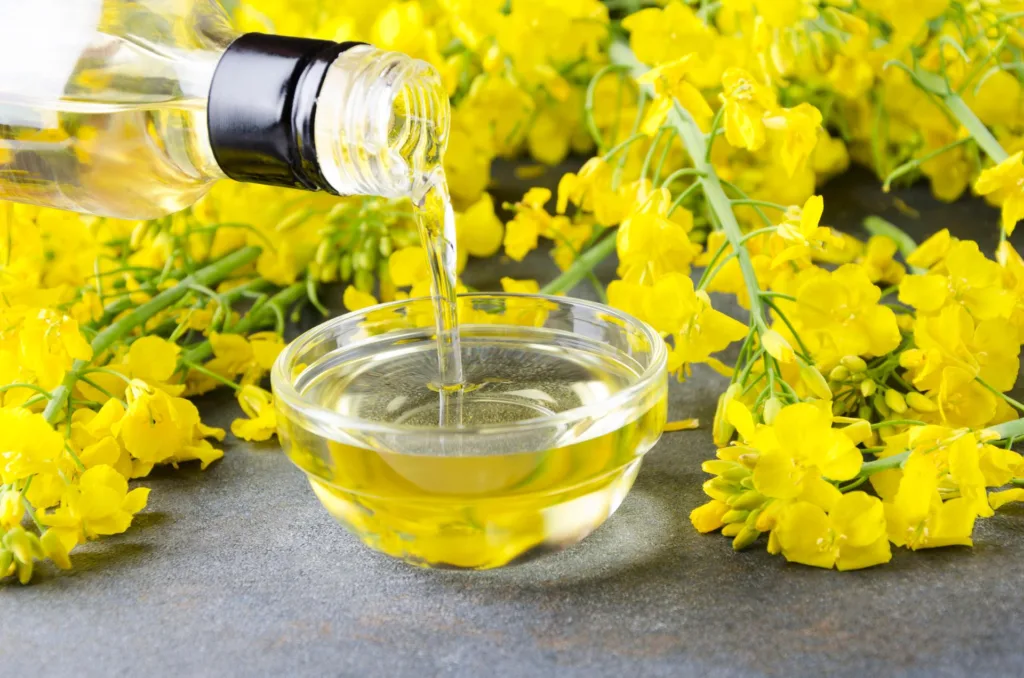
Canola oil is a type of vegetable oil extracted from the seeds of the canola plant. It can aid in weight loss due to its high levels of both mono- and poly-unsaturated fats (41).
Canola oil also has a high smoke point. It’s great for high-temperature cooking and avoiding harmful compounds released when fat burns (61). It can also be used in salad dressings, and it’s good for baking.
16‒20: Vegetables
Whether you enjoy them raw, steamed, roasted, or grilled, more veggies mean greater weight loss. This is because their plentiful essential vitamins and minerals improve metabolism, which increases fat-burning (62).
Moreover, vegetables are low in calories, making them a perfect choice for losing weight. Veggies are also excellent sources of fiber, which helps delay hunger (62). Plus, their vibrant colors can really elevate a meal.
Studies show that consuming more than four servings of veggies per day can help reduce the risk of weight gain (63).
Let’s kickstart your healthy weight loss with these five vegetables:
16. Spinach
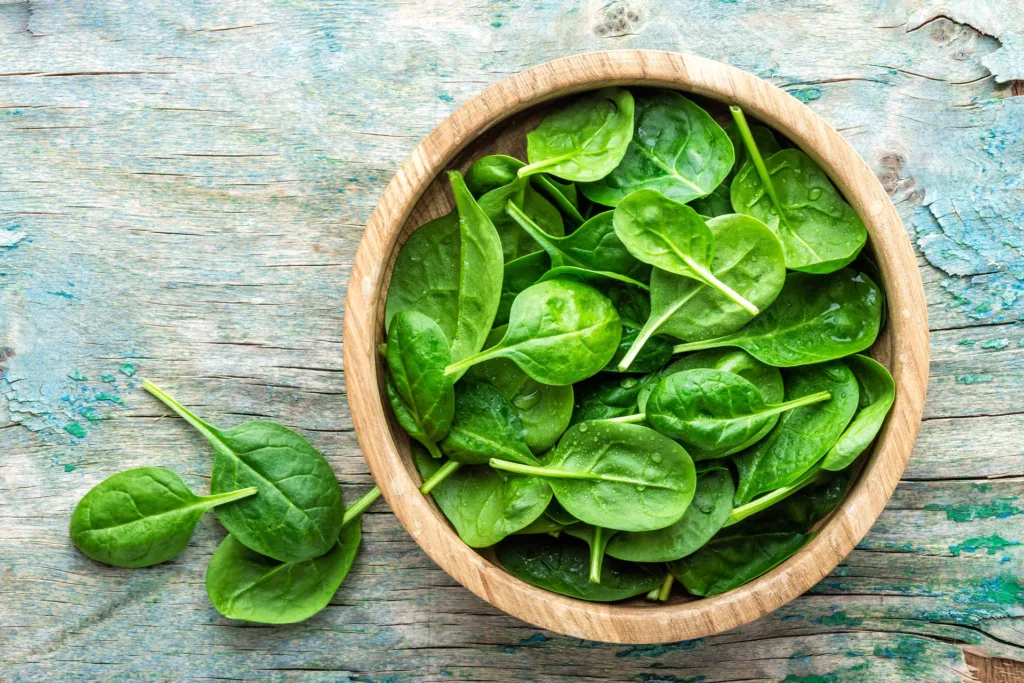
Spinach is a bomb-diggity for fiber, vitamins, and minerals. It also keeps you hydrated, and feeling full for longer, thereby eating fewer calories (64).
Spinach contains thylakoids. These compounds can boost satiety and improve appetite management, leading to better food choices and portion control (65, 66, 67).
Other thylakoid-rich leafy greens like kale, Swiss chard, and collard greens are other potential alternatives.
17. Broccoli
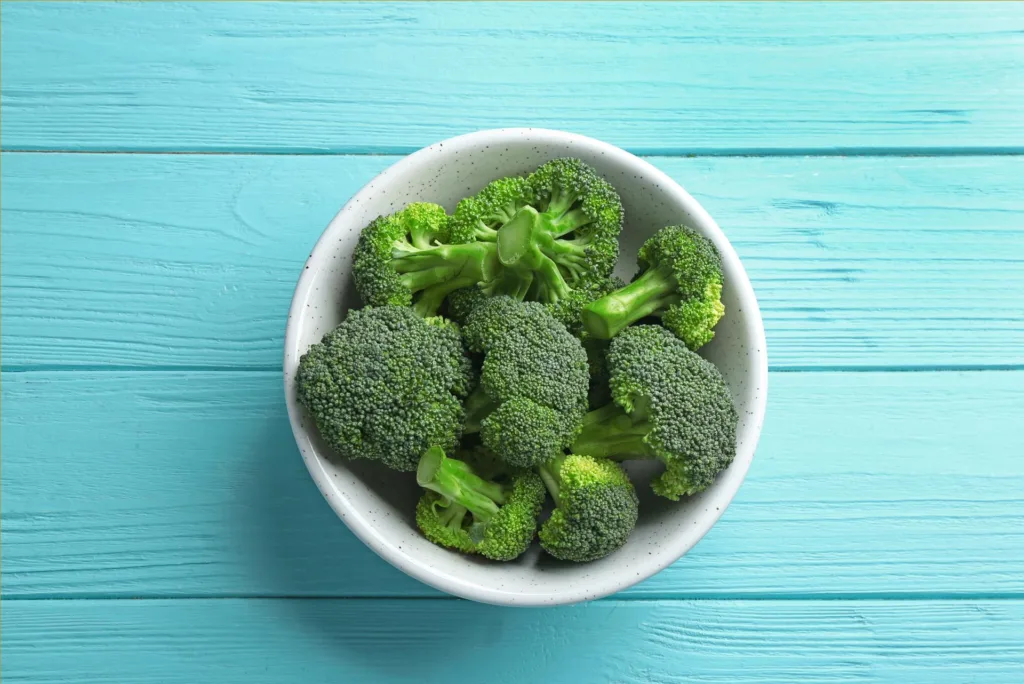
Broccoli is a cruciferous, low-calorie vegetable well-known for its health benefits, including cancer prevention (68). It’s also a high-protein vegetable, making it super filling and satisfying (69). Legumes, however, are a better protein choice.
Broccoli also contains a unique compound called sulforaphane. This actually helps you burn fat more efficiently by reducing inflammation (70, 71). Sulforaphane is thought to be easier for your body to absorb than many other nutrients (72).
18. Carrots
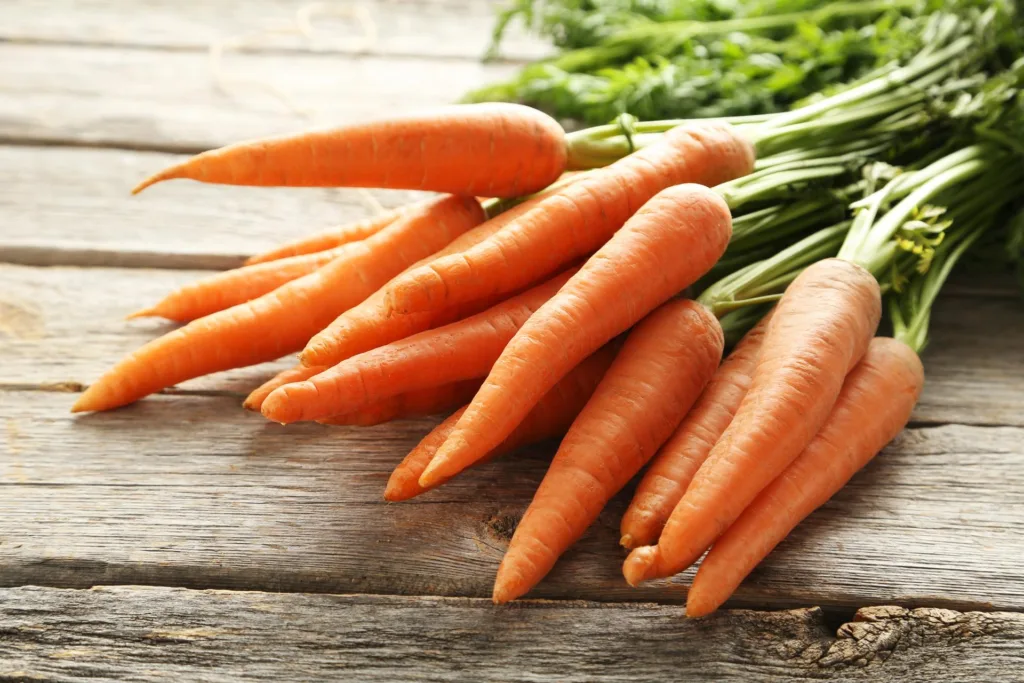
Carrots are one of the most versatile root vegetables. They have many essential nutrients, such as vitamin A, vitamin K, and potassium (which many people lack). Carrots are also incredibly low in calories (73).
Eating carrots reduce hunger pangs and aid in digestion due to their high fiber content. They also contain antioxidants that lower inflammation and protect against chronic diseases (74).
For an extra creative take on this superfood, try making carrot fries cooked in canola oil. Other similarly healthy root vegetables are sweet potatoes, turnips, and beets.
19. Cucumbers
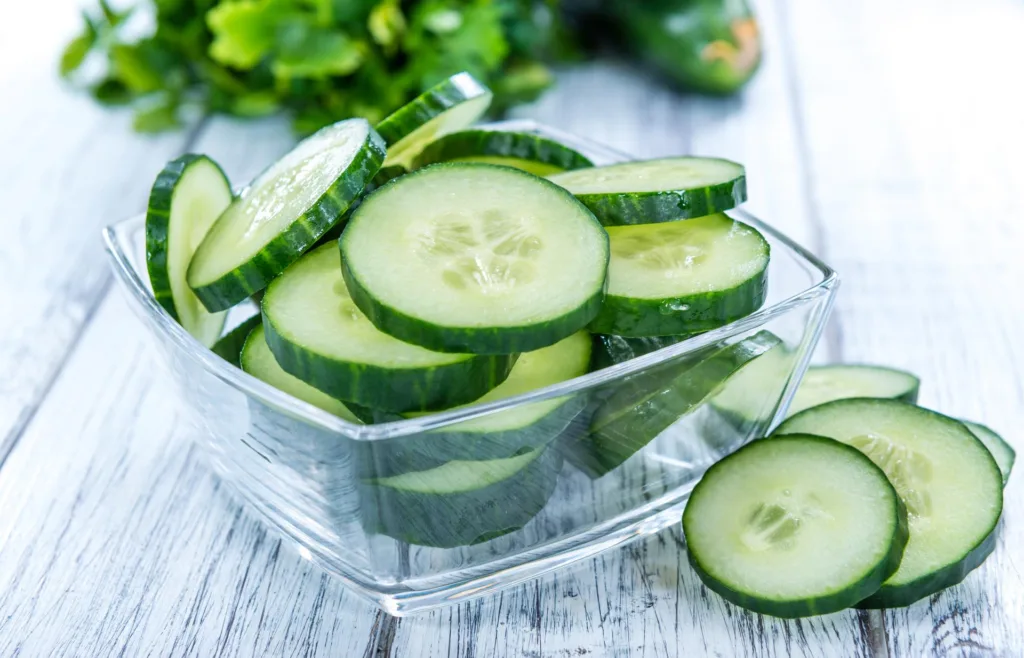
Cucumbers are water bombs filled with vitamin K, vitamin C, and potassium (75).
Apart from satiating effects, cucumbers are high in sulfur and silicone, which help the body get rid of fat (76). Plus, they contain antioxidants that lower inflammation.
20. Bell peppers
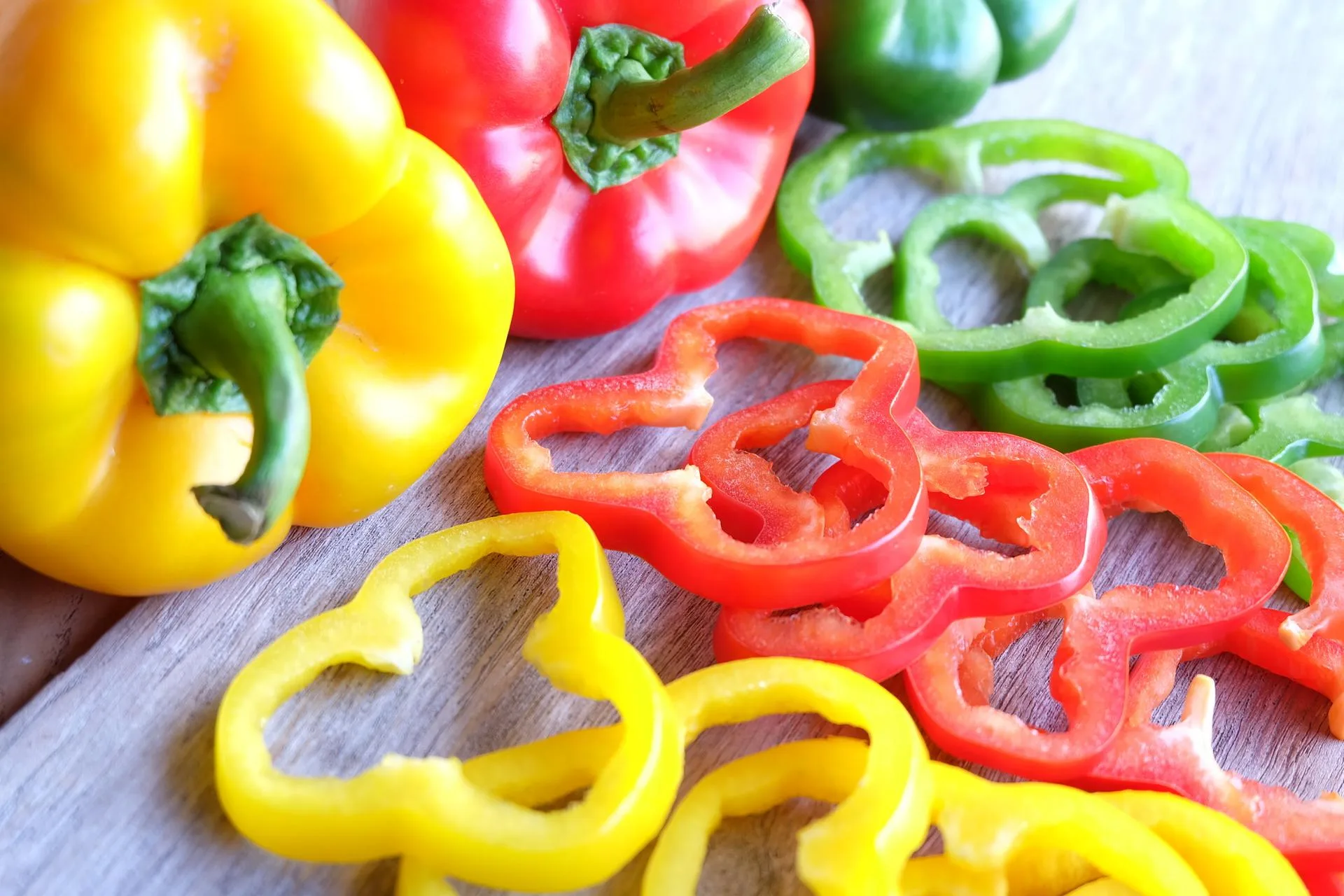
Bell peppers are some of the most colorful and versatile veggies. Whether you prefer green, red, yellow, or orange, they are flavorful and filled with fiber and other nutrients to help you lose weight (77).
Their high vitamin A and C content can contribute to healthier eyesight and better immunity (78, 79). Capsaicin, which gives bell peppers their pungent flavor, can boost metabolism and promote fat burning (80).
Apart from salads and sauteing, stuffed bell peppers with lean protein and rice are an excellent combination. Roasting, grilling, or barbecuing is the best way to bring out their natural sweetness.
21‒25: Fruits
It’s recommended that half of any healthy meal should consist of vegetables and fruits, but excluding potatoes (81)! Fruits are key to many essential vitamins and minerals that keep the body healthy and energized.
Some people may think that fruits are food to avoid because they contain sugar. However, some fruits do have fat-burning properties (76).
The water content in fruit is always a plus for weight loss, as is the fiber, but phytochemicals in fruit may even help you fight obesity (82, 83).
If you’re looking for sustainable weight loss, the following five low-glycemic fruits are a great place to start (84).
21. Apples
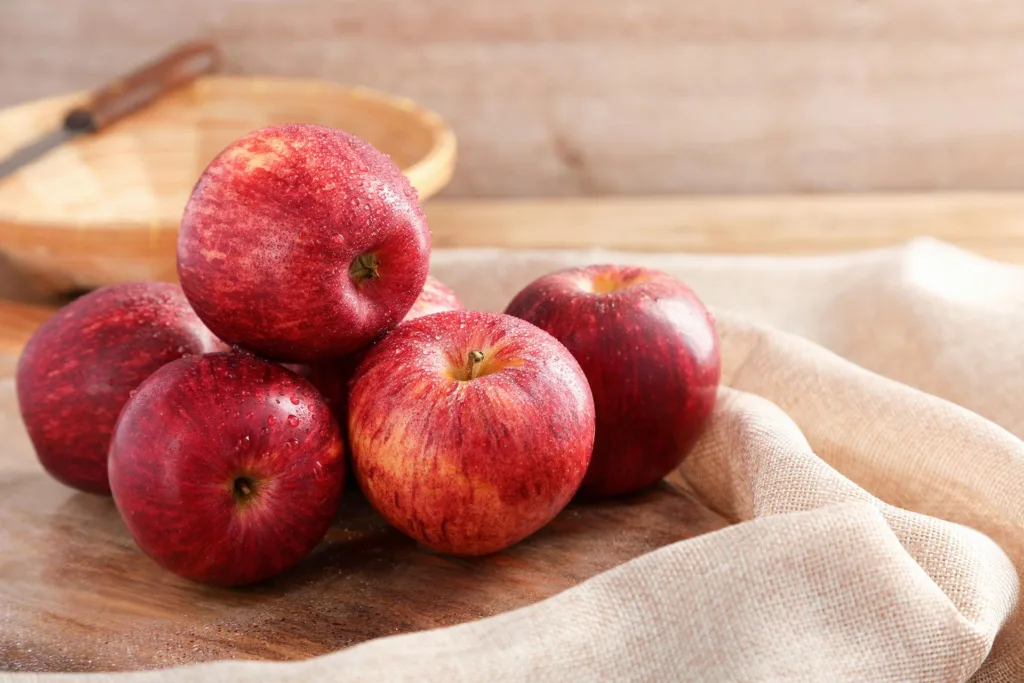
Apples actually have nutrients that can limit the ability of your body to absorb fat (76).
A soluble fiber called pectin, found in apples, can lower cholesterol levels and benefit your gut health (76, 85). Additionally, the polyphenols in apples have anti-inflammatory effects, which also foster healthy weight loss.
For a fiber-rich breakfast, pair sliced apples with a tablespoon of almond butter or add diced apples to your oatmeal. Apples are also surprisingly good in coleslaw or go well thinly sliced in a turkey sandwich.
22. Grapefruit
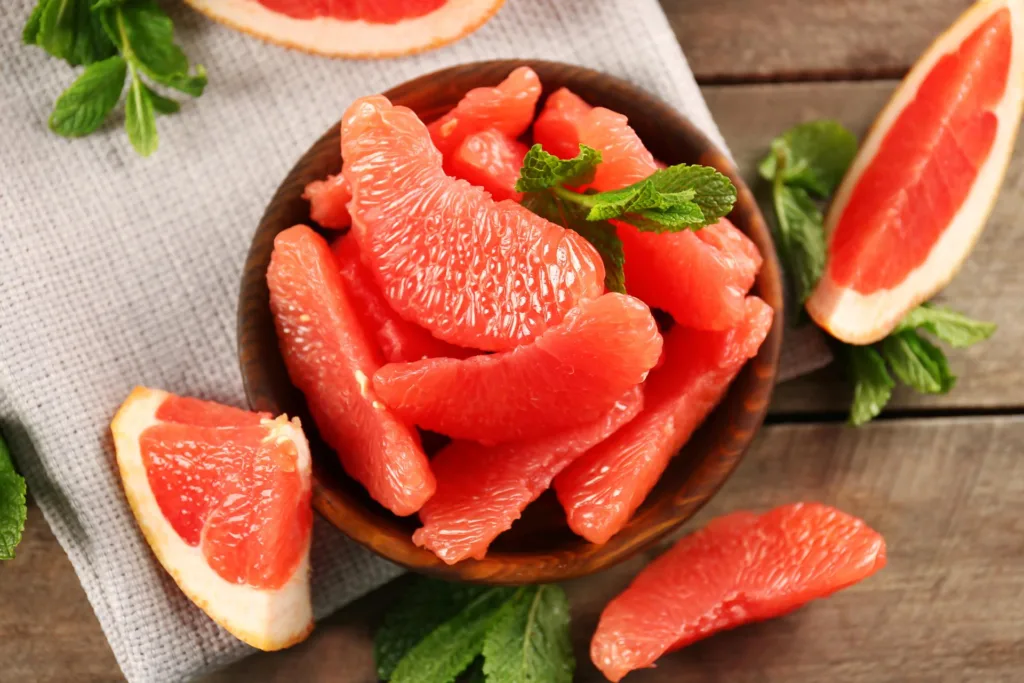
Grapefruit is well-known for its high-fiber content. During digestion, grapefruit burns more calories than it contains (76).
Additionally, grapefruit is 90% water which helps flush out excess bodily fluids, reducing the risk of dimpled skin or cellulite (76, 86).
With its citrus magic powers, the high vitamin C and acidity of grapefruit can dilute fat and cholesterol. Grapefruit can also help improve lipid profiles and release fat cells (76, 87).
Grapefruit adds a tangy twist to various types of salads, but don’t shy away from blending it into a nutritious smoothie.
23. Kiwi
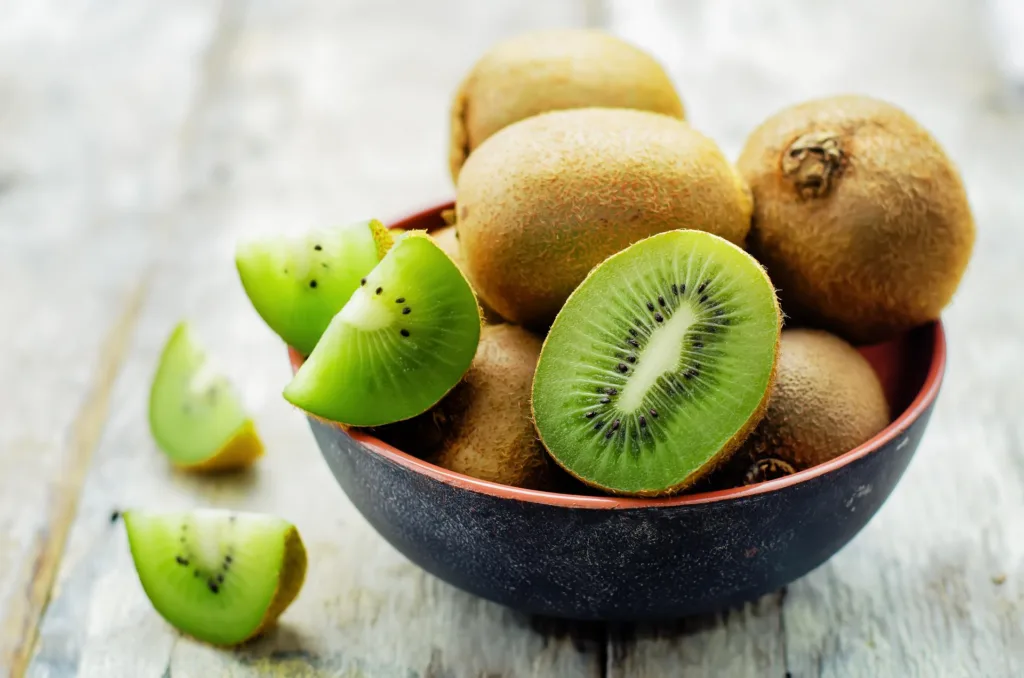
Kiwi is a small, nutrient-dense fruit that is an excellent source of fiber and low in calories (88, 89). What sets the kiwi apart is its unique fiber which retains water more than other types of fibers, thus strengthening your digestive health.
The high vitamin C and other antioxidant content in kiwi is a key for weight loss. A reduction in any inflammation can release fat cells and trigger weight loss (76).
Kiwis are best eaten raw to maximize their unique health benefits. They go just as well thinly sliced into a salad or double up their punch with Greek yogurt.
24. Oranges
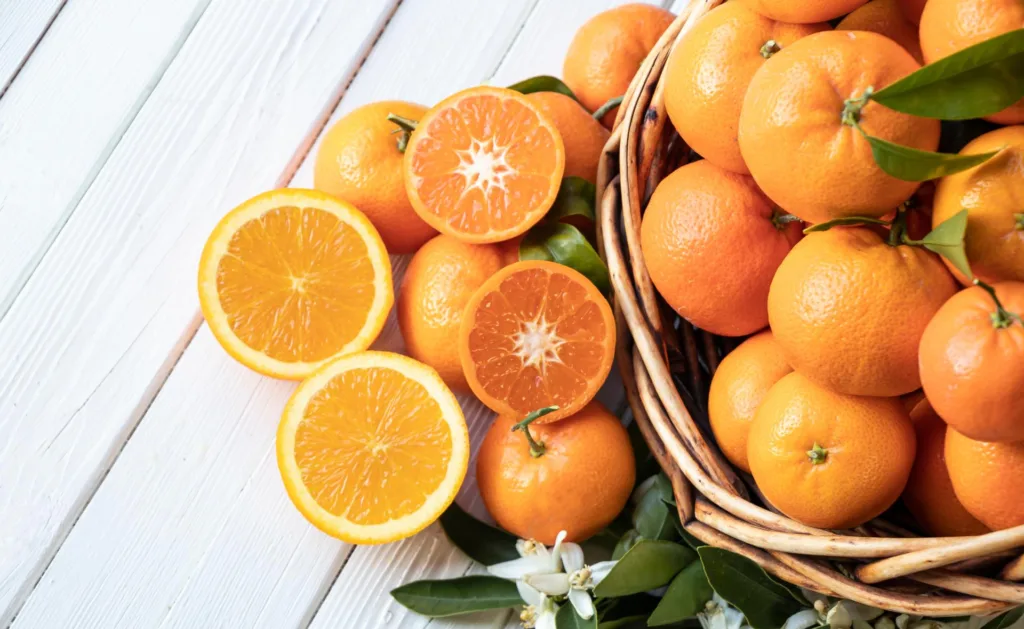
Juicy oranges, famed for their vitamin C, are likewise rich in fiber to keep you feeling full. While orange juice is a common choice, eating whole fruit is best for the benefits of fiber and other nutrients (76, 90).
Eating oranges regularly can support your brain and immune system while lowering the risk of chronic diseases like heart disease and cancer (91).
Although versatile, from salads to sauces and baked goods, don’t forget about the peel. After washing well, orange peels can be roasted or grilled and brushed with honey for a satisfying snack!
Other citrus fruits like lemons, limes, and clementines are also rich in vitamin C, with flavors from slightly tart to sour.
25. Pomegranate
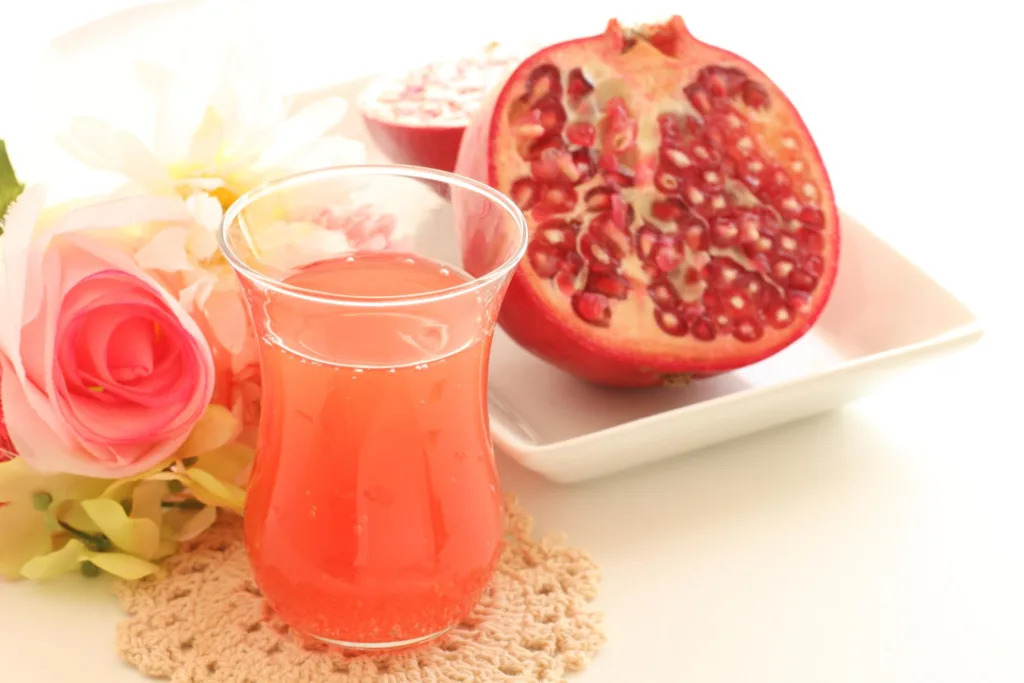
Pomegranates are especially high in fiber and antioxidants that can help you drop some extra pounds (92).
Their polyphenol content also helps to improve insulin sensitivity, regulate blood sugar, and reduce excess fat storage (93).
Pomegranate seeds are enjoyable to eat as they are, but most people prefer them sprinkled into salads or blended into sauces and smoothies. You can get a double fiber, healthy fats, and protein boost by mixing them in with oatmeal and Greek yogurt.
Tips for creating a healthy meal plan
Formulating a well-balanced meal plan is crucial when it comes to shedding unwanted pounds. Besides, staying on track means avoiding unhealthy foods.
Experts suggest planning meals is the most effective means of getting adequate nutrition. While certain foods are better than others for weight loss, a balanced diet will help you more than anything else (42).
The core principle is to pay heed to portion control and change your eating habits to include a variety of nourishing foods. Going for satiating food groups like fiber, protein, healthy fats, and complex carbs is an effective strategy (76).
The other key is to align with your physical needs. At the same time, you must steer clear of sugary and processed foods, which can cause weight gain and wreak havoc on the body (94, 95).
A couple of tips to eliminate unhealthy foods are to cook at home and practice mindful eating. Avoid feeling guilty about food, savor every bit, and focus on the nourishing aspects of your new diet.
7-Day Healthy Meal Plan for Healthy Weight Loss
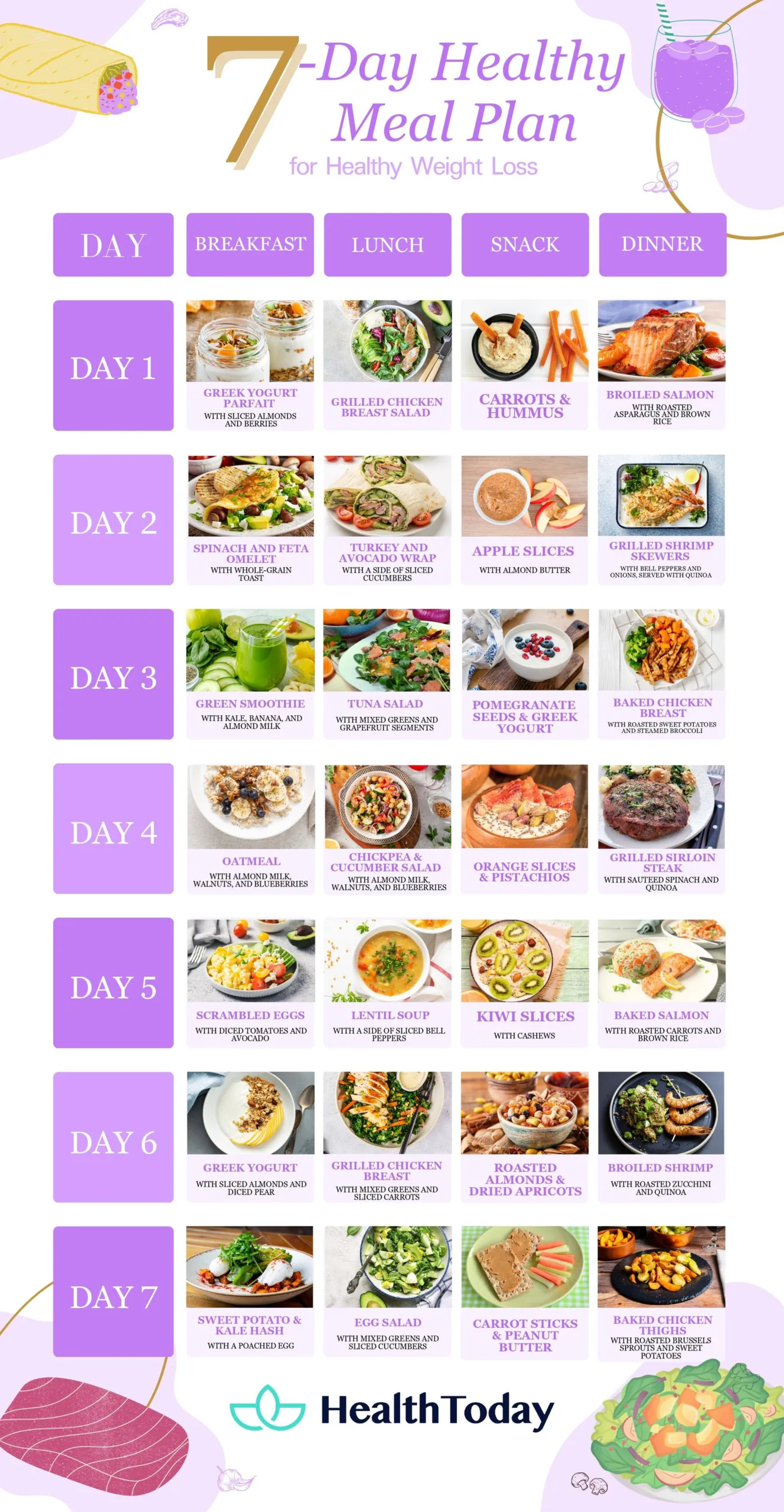
Our comprehensive seven-day program features easy-to-get nutritious and palatable foods to keep you satisfied and energized throughout the week.
Day 1
- Breakfast: Greek yogurt parfait with sliced almonds and berries
- Lunch: Grilled chicken breast salad with mixed greens, avocado, and bell peppers
- Snack: Carrots and hummus
- Dinner: Broiled salmon with roasted asparagus and brown rice
Day 2
- Breakfast: Spinach and feta omelet with whole-grain toast
- Lunch: Turkey and avocado wrap with a side of sliced cucumbers
- Snack: Apple slices with almond butter
- Dinner: Grilled shrimp skewers with bell peppers and onions, served with quinoa
Day 3
- Breakfast: Green smoothie with kale, banana, and almond milk
- Lunch: Tuna salad with mixed greens and grapefruit segments
- Snack: Pomegranate seeds and Greek yogurt
- Dinner: Baked chicken breast with roasted sweet potatoes and steamed broccoli
Day 4
- Breakfast: Oatmeal with almond milk, walnuts, and blueberries
- Lunch: Chickpea and cucumber salad with lemon vinaigrette
- Snack: Orange slices and pistachios
- Dinner: Grilled sirloin steak with sauteed spinach and quinoa
Day 5
- Breakfast: Scrambled eggs with diced tomatoes and avocado
- Lunch: Lentil soup with a side of sliced bell peppers
- Snack: Kiwi slices with cashews
- Dinner: Baked salmon with roasted carrots and brown rice
Day 6
- Breakfast: Greek yogurt with sliced almonds and diced pear
- Lunch: Grilled chicken breast with mixed greens and sliced carrots
- Snack: Roasted almonds and dried apricots
- Dinner: Broiled shrimp with roasted zucchini and quinoa
Day 7
- Breakfast: Sweet potato and kale hash with a poached egg
- Lunch: Egg salad with mixed greens and sliced cucumbers
- Snack: Carrot sticks and peanut butter
- Dinner: Baked chicken thighs with roasted Brussels sprouts and sweet potatoes
Lastly, drink plenty of water and listen to your body’s hunger and fullness cues to adjust portion sizes. Let the nourishing foods guide you on the way to a healthier and happier you.
How can I make healthy food choices when eating out?
When eating out, try making healthy food choices by looking for grilled or steamed dishes. Opt for smaller portions or share a dish, request dressings and sauces on the side, and skip fried or creamy dishes.
Are all carbohydrates bad for weight loss?
Not all carbohydrates are bad for a weight loss diet. Complex carbohydrates such as those found in whole grains, fruits, and vegetables provide essential nutrients and are beneficial.
Is it okay to snack while trying to lose weight?
Snacking is totally okay when trying to lose weight, as long as you go for healthy options in appropriate portions. High-protein snacks such as nuts or Greek yogurt can help curb hunger and prevent overeating at meals.
How can I stay motivated to eat healthy foods and lose weight?
Staying motivated to eat healthily and lose weight can be done by setting achievable goals and tracking progress. Also, find a peer support group, reward yourself for progress, and focus on the benefits of a healthy lifestyle.
Summary
Here are several key things to keep in mind when it comes to choosing the foods for weight loss:
- A healthy weight loss diet needn’t be exhausting. You can still enjoy your favorite foods while maintaining a healthy weight. Simply choose foods wisely.
- It’s best to include whole foods, such as whole grains or legumes; lean proteins like chicken or fish; beneficial fats, such as those found in nuts or avocados; and various nutritious fruits and vegetables.
- No single food or fad food is a magic pill. You’re more likely to lose weight by focusing on the overall quality of your diet. Start with well-balanced meal plans that include a variety of nutrient-dense foods. Practicing portion control and mindful eating habits.
Losing weight can be challenging, so it’s important to be patient and consistent in your efforts.







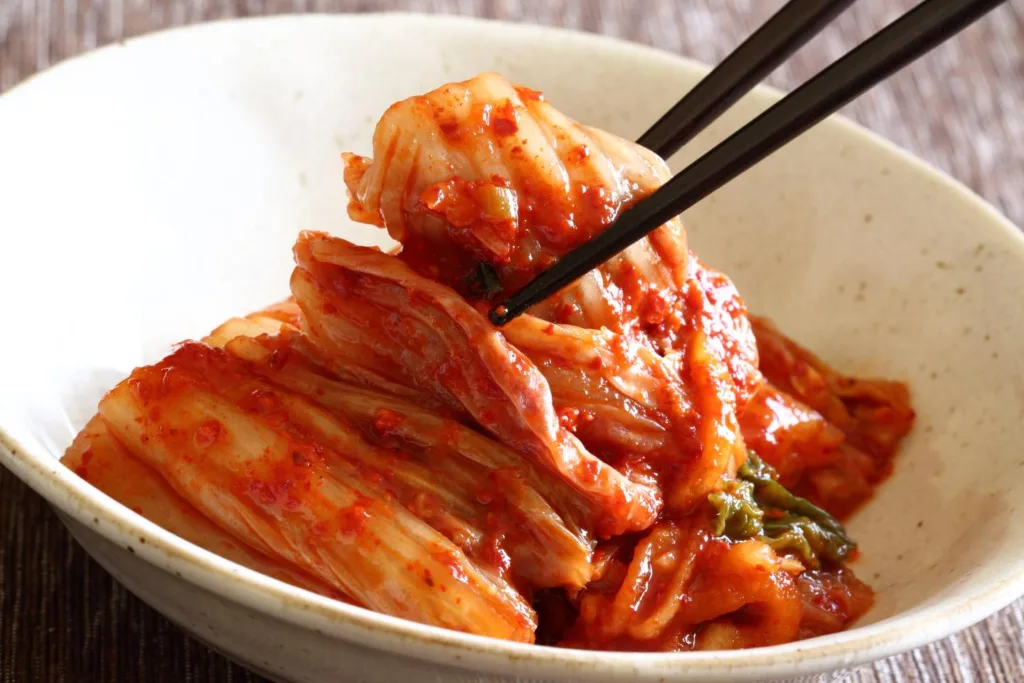

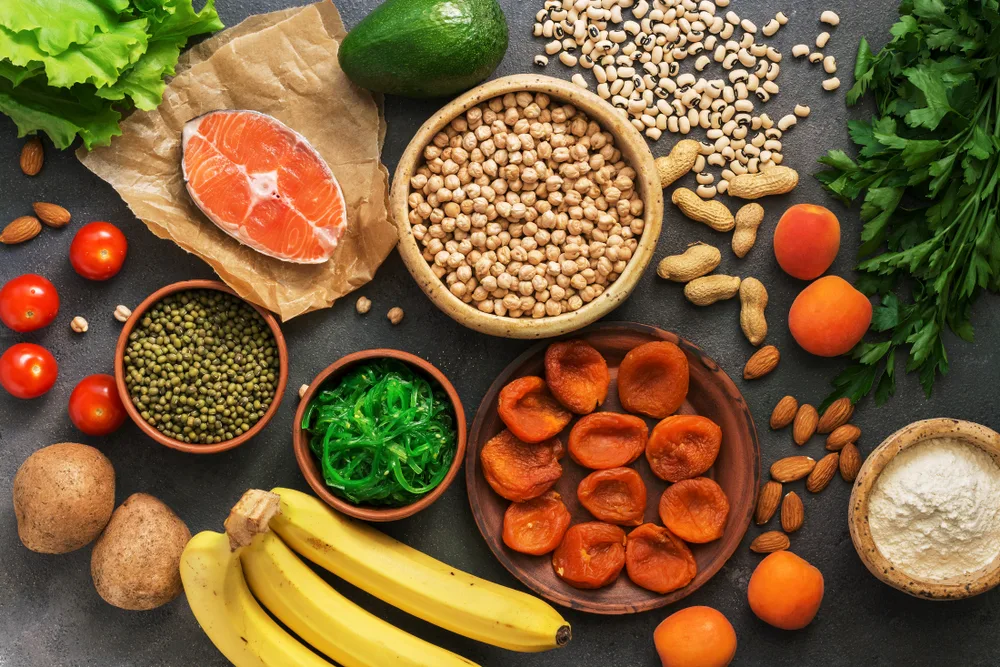




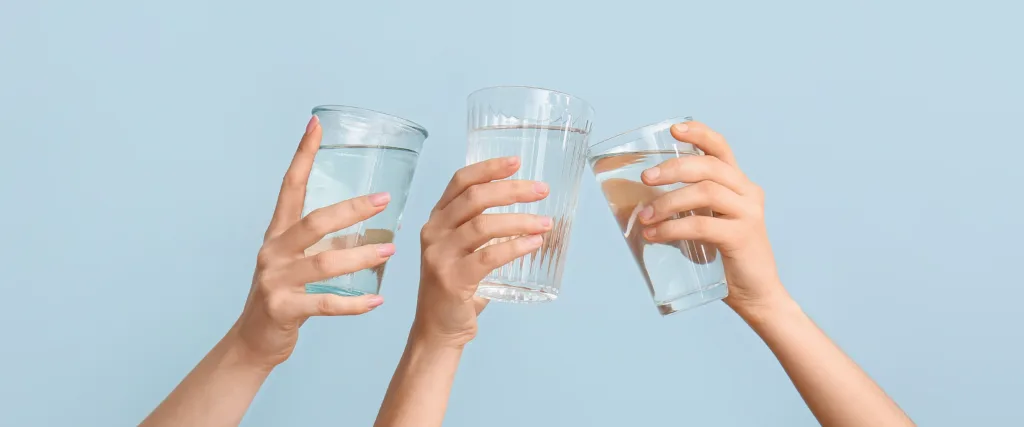

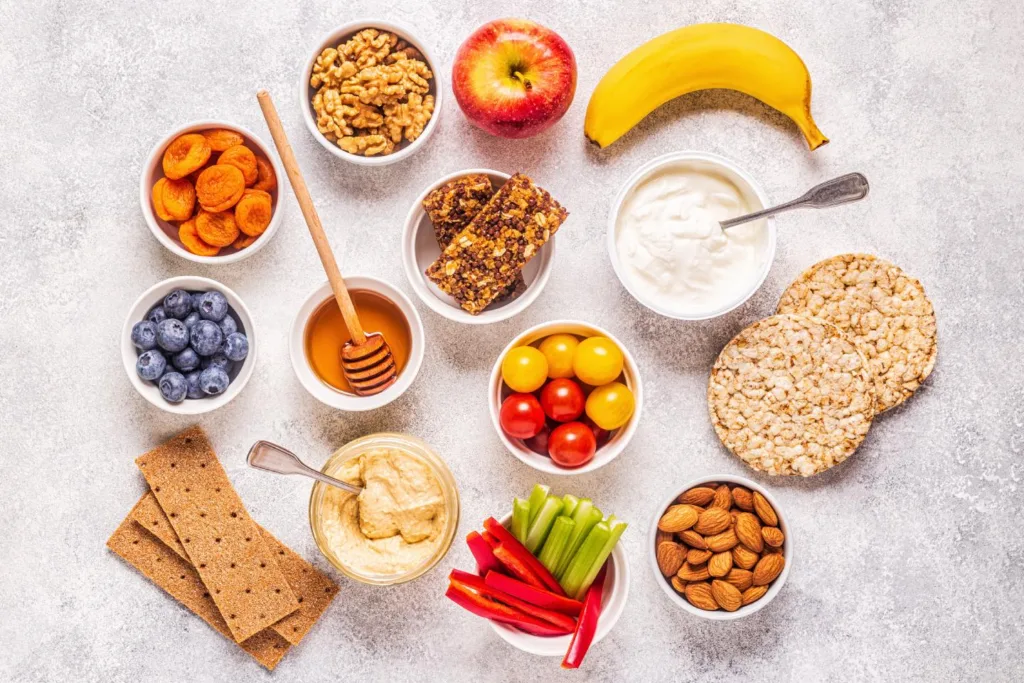
Comments
0